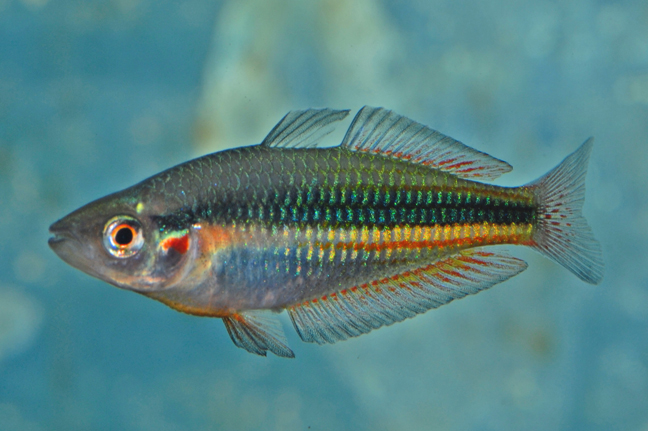Crimsonspotted Rainbowfish, Melanotaenia duboulayi (Castelnau 1878)

Crimsonspotted Rainbowfish, Melanotaenia duboulayi. Source: Rudie H. Kuiter / Aquatic Photographics. License: All rights reserved
A popular aquarium fish with a highly variable colour pattern depending on locality. Males and females are markedly sexually dimorphic.
Body olive-brown above, silvery to greenish-blue on sides and white below - becoming yellowish-orange towards rear of body;
Sides with a darkish midlateral stripe and thin reddish stripes;
Gill cover with a reddish spot.
Adult males have a deeper body and are more brightly coloured than females, especially when breeding. Males often have red spots on the caudal, dorsal and anal fins, and develop dark fin margins when breeding.
Video of Crimsonspotted Rainbowfish (Snapper Creek variety)
Crimsonspotted Rainbowfish, Melanotaenia duboulayi (Castelnau 1878)
More Info
|
Distribution |
Eastern Australia, from the Mary River, Queensland to the Macleay River, New South Wales. Inhabits a range of freshwater environments environments including rivers, creeks, drains, ponds, dune lakes and reservoirs in sandy coastal areas and inland forest habitats. |
|
Features |
Dorsal fin V-VIII + I,8-13; Anal fin I,15-21; Pectoral fin 12-15; Caudal fin 15-17; Gill rakers 11-12; Vertebrae 27-32. Body relatively elongate, slender, laterally compressed, becoming deeper with age; males with deeper body; mouth oblique, extends back to almost below anterior margin of eye; upper jaw protruding; jaw teeth conical to canine-like in several rows extending outside mouth; teeth present on vomer and palatines; head moderately sized, eye relatively large; lateral line absent. Scales large, extending to cheek; vertical scale rows 33-36; horizontal scale rows 11-13. Two separate dorsal fins; origin of first dorsal between origins of pelvic and anal fins; origin of 2nd dorsal fin behind origin of anal fin; dorsal fins separated by a small gap; anal fin long-based; caudal fin slightly forked; males with higher first dorsal and pointed tips of anal and dorsal fins, rounded in females. |
|
Size |
To 11cm SL, commonly to 8cm |
|
Colour |
Males more brightly coloured than females, especially when breeding; colour patterns vary with locality; dorsal surface generally olive brown, sides silvery to greenish blue, ventral surface white, yellow orange toward tail; thin reddish stripe between each horizontal scale row; usually with a red spot on upper gill cover and a diffuse black midlateral stripe; fins clear in juveniles and females; males often with red spots on caudal, dorsal and anal fins. |
|
Feeding |
Omnivore - feeds on terrestrial insects, aquatic insects, algae, charaphytes, macrophytes, micro and macro crustaceans, fish eggs, terrestrial vegetation and molluscs. |
|
Biology |
Entire lifecycle is completed in freshwater; sexually mature at 10-12 months; spawns from late winter to summer with peak spawning activity in spring and summer; spawning is likely to occur in beds of aquatic macrophytes and submerged vegetation where eggs are deposited within 10cm of the water surface. |
|
Remarks |
|
|
Etymology |
The species is named in honour of Mr. Duboulay, who collected type specimen. |
|
Species Citation |
Atherinichthys duboulayi Castelnau, 1878, Proc. Linn. Soc. N.S.W. (1)3(2): 143. |
|
Author |
Gomon, M.F. & Bray, D.J. 2022 |
|
Resources |
Crimsonspotted Rainbowfish, Melanotaenia duboulayi (Castelnau 1878)
References
Allen, G.R. 1989. Freshwater Fishes of Australia. Neptune, New Jersey : T.F.H. Publications 240 pp., 63 pls.
Allen, G.R., Midgley, S.H. & Allen, M. 2002. Field Guide to the Freshwater Fishes of Australia. Perth : Western Australian Museum 394 pp.
Brown, C., Unmack, P. & Hammer, M. 2019. Melanotaenia duboulayi. The IUCN Red List of Threatened Species 2019: e.T122905910A123382236. https://dx.doi.org/10.2305/IUCN.UK.2019-3.RLTS.T122905910A123382236.en. Accessed on 07 June 2022.
Caller, G. & Brown, C. 2013. Evolutionary Responses to invasion: cane toad sympatric fish show enhanced avoidance learning. PLoS ONE 8(1): e54909. doi:10.1371/journal.pone.0054909
Cashner, R.C., Hawkes,G.P., Gartside, D.F. & Marsh-Matthews E. 1999. Fishes of the Nymboida, Mann and Orara Rivers of the Clarence River Drainage, New South Wales, Australia. Proceedings of the Linnean Society of New South Wales 121: 89-100
Castelnau, F.L. de 1878. On some new Australian (chiefly) freshwater fishes. Proceedings of the Linnean Society of New South Wales 1 3(2): 140-144 (originally described as Atherinichthys duboulayi) See ref at BHL
Crowley, L.E.L.M., Ivantsoff, W. & Allen, G.R. 1986. Taxonomic position of two crimson-spotted rainbowfish, Melanotaenia duboulayi and Melanotaenia fluviatilis (Pisces: Melanotaeniidae), from Eastern Australia, with special reference to their early life-history stages. Australian Journal of Marine and Freshwater Research 37: 385-398 figs 1-6 https://doi.org/10.1071/MF9860385
De Vis, C.W. 1884. New fishes in the Queensland Museum. No. 4. Proceedings of the Linnean Society of New South Wales 1 9(3): 685-698 (described as Aristeus perporosus, type locality Maryborough, Queensland)
Hattori, A.& Warburton, K. 2003. Microhabitat use by the rainbowfish Melanotaenia duboulayi in a subtropical Australian stream. Journal of Ethology 21: 15-22.
Johnson, J. 1993. Fishes of the Brisbane River. Fishes of Sahul, Journal of the Australian New Guinea Fishes Association 8(1): 347-352
Leggett, R. & Merrick, J.R. 1987. Australian Native Fishes for Aquariums. Artarmon : J.R. Merrick Publications 241 pp. 142 figs.
Macleay, W.J. 1881. Descriptive catalogue of the fishes of Australia. Part 2. Proceedings of the Linnean Society of New South Wales 1 5(4): 510-629 pls 13-14 (described as Aristeus lineatus, type locality Richmond River, NSW)
McDowall, R.M. (ed.) 1996. Freshwater Fishes of South-eastern Australia. Sydney : Reed Books 247 pp.
Pusey, B.J., Kennard, M.J. & Bird, J. 2000. Fishes of the dune fields of Cape Flattery, northern Queensland and other dune systems in north-eastern Australia. Ichthyological Exploration of Freshwaters 11(1): 65-74.
Smith, S., Brauer, C.J., Sasaki, M., et al. 2020. Latitudinal variation in climate-associated genes imperils range edge populations. Molecular Ecology 29: 4337–4349. https://doi.org/10.1111/mec.15637
Warburton, K. & Madden, C. 2003. Behavioural responses of two native Australian fish species (Melanotaenia duboulayi and Pseudomugil signifer) to introduced poeciliids (Gambusia holbrooki and Xiphophorus helleri) in controlled conditions. Proceedings of The Linnean Society of New South Wales, 124: 115-123.




